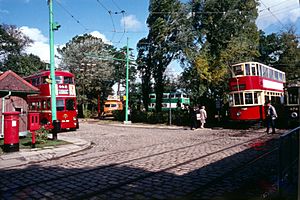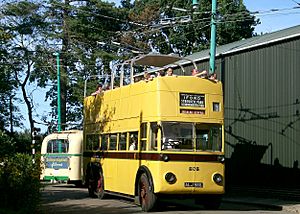East Anglia Transport Museum facts for kids

Preserved former London (first generation) tram and trolleybus at the East Anglia Transport Museum
|
|
| Lua error in Module:Location_map at line 420: attempt to index field 'wikibase' (a nil value). | |
| Established | 1965 |
|---|---|
| Location | Carlton Colville, Lowestoft, Suffolk |
| Type | Heritage centre |
The East Anglia Transport Museum is a special outdoor museum. It has many old public transport vehicles. Some of these vehicles can still be driven! The museum is located in Carlton Colville, which is a suburb of Lowestoft in Suffolk. It is the only museum in the United Kingdom where visitors can ride on buses, trams, and trolleybuses. You can also ride on a narrow-gauge railway here.
Contents
History of the Museum
The museum started in 1965 at its current location in Carlton Colville. Its beginning was quite interesting! In 1962, four people who loved old transport vehicles saved the body of an old Lowestoft tram (number 14). This tram body had been used as a summerhouse for many years.
The land for the museum was once a meadow. It was given by Albert Bird, who was the founder and first chairman of the Museum Society. The first buildings were built in 1966. The museum first opened its doors to the public on May 28, 1972. Full tram and trolleybus rides began in 1981. This was after a proper road was built for them.
The East Suffolk Light Railway
The museum also has a narrow-gauge railway. It is called the East Suffolk Light Railway. This railway opened in 1973. It was about 300 meters (300 yards) long. It ran along the northern edge of the museum site. The railway tracks were 2 feet wide. Materials for the tracks came from different places, like a sand quarry and Canvey Island. The museum even has a van body that used to run on the Southwold Railway.
Museum Expansion
In 2016, the museum bought more land next to its main site. The local council agreed to the museum's plans to expand. They knew the museum was good for the local area. The plan was to make the tramway, trolleybus route, and narrow-gauge railway longer. This would almost double the size of the museum! It was estimated to cost about one million pounds.
A new exhibition hall was planned. It would be about Eastern Coach Works. This company built many bus and train bodies in nearby Lowestoft until it closed in 1987. New depots for trams and trolleybuses were also planned. Twenty vehicles that were stored in another location were to be moved to the Carlton Colville site. This way, more people could see them.
The East Suffolk Light Railway was extended first. A special flat crossing was built so trains could go over the tramway. In April 2023, a new tram depot opened. It has space for six tramcars.
Vehicles on Display
The museum has many different vehicles. They range from a 1904 Lowestoft Corporation tram to a 1985 Sinclair C5. You can take tram rides on a route that goes past the museum's trolleybus depot. It ends at a place called Woodside.
The trolleybus route used to go as far as the trolleybus depot. Passengers could then switch to the 2-foot gauge railway. Or, they could stay on the trolleybus as it turned around and went back to the museum entrance.
A muddy field was paved and named Herting Street. This was named after a person who helped pay for the work. On July 12, 2008, a new loop opened along Herting Street. This connected to the existing overhead wires near the museum's entrance. It was the first trolleybus route extension in Britain for many decades!
One special exhibit is No. 1521. This was the last trolleybus to run on its own power in London. London used to have the world's largest trolleybus network. This trolleybus was built in 1939–40. It made its very last journey on the evening of May 8, 1962.
Here are some of the vehicles you can see at the museum:
Trams at the Museum
- Blackpool Corporation VAMBAC single-decker No. 11 (built 1939). It is working.
- Lowestoft Corporation Tramways open-top No. 14 (built 1904). It is being fixed up.
- Blackpool Corporation Standard Class double-decker No. 159 (built 1927). It is working.
- Amsterdam Tramways single-decker No. 474 (built 1929). It is working.
- Glasgow Corporation Tramways double-decker No. 488 (built 1903). It is being fixed up.
- Sheffield Corporation double-decker No. 513 (built 1950). It is working and on loan from Beamish Museum.
- London Transport HR2 No. 1858 (built 1930). It is working.
- Blackpool Corporation Double Deck Streamliner “Balloon” No. 726 (built 1935). It is waiting to be fixed up.
- Blackpool Corporation Brush Car No. 627 (built 1935). It is being fixed up.
- Blackpool Corporation Brush Car No. 625 (built 1935). It is not working.
Trolleybuses at the Museum
- 1 Henschel Solingen (owned by a private person)
- 5 Garrett 1926 Copenhagen
- 34 Sunbeam 1947 Hastings Corporation
- 52 BUT 9611T 1953 Maidstone Corporation Transport
- 87 BUT 9612T 1956 Ashton-Under-Lyne Corporation
- 202 Sunbeam 1935 Bournemouth Corporation
- 224 Sunbeam 1953 Derby Corporation (away for repairs)
- 237 Sunbeam 1960 Derby Corporation (owned by a private person)
- 246 Sunbeam 1958 Belfast Corporation
- 260 AEC 1936 London Transport
- 286 Sunbeam 1959 Bournemouth Corporation
- 313 BUT 1951 Portsmouth Corporation
- 628 BUT 1950 Newcastle Corporation
- 1201 Leyland 1938 London Transport
- 1521 Chassisless Construction by Metro-Cammell using AEC parts 1940 London Transport
- 578 Nottingham City Transport (built 1951)
- 105 Ipswich Corporation (built 1948, on loan from Ipswich Transport Museum)
Motorbuses at the Museum
- 21 AEC Regent II 1947 Lowestoft Corporation
- LL408 Bristol 1948 Eastern Counties
- LFL57 Bristol Lodekka 1962 Eastern Counties
- 4 AEC Swift 1969 Lowestoft Corporation
- 85 AEC Reliance 1964 Great Yarmouth
- VR385 Bristol VR 1972 Eastern Counties
- 13 Mercedes-Benz 608D 1987 Lincolnshire Road Car
- 66 Leyland PD2/1 1949 Great Yarmouth Corporation
- 62 Dennis Dart 1995 Great Yarmouth Transport
- 8 AEC Regent V 1963 Lowestoft Corporation
- RTL 1163 1946 London Transport
- RT 3125 1950 London Country
Locomotives on the Railway
There are four locomotives that run on the 2-foot gauge East Suffolk Light Railway (ESLR). All of them have four wheels. They use diesel engines and mechanical gears. One was made by Ruston and Hornsby and three by Motor Rail. The parts of a fourth Motor Rail locomotive were used to make a brakevan.
| Number | Name | Type | Manufacturer | Built | History |
|---|---|---|---|---|---|
| 2 | Aldburgh | 4wDM | Motor Rail | 1934 | Used by British Industrial Sands, King's Lynn |
| 4 | Leiston | 4wDM | Ruston & Hornsby | 1936 | Used by Portland Cement, Lewes |
| No.5 | Orfordness | 4wDM | Motor Rail | 1964 | Used by East Suffolk and Norfolk River Authority. Later loaned to the Imperial War Museum, Duxford, and then permanently to ESLR in 1997. |
| No.6 | Thorpness | 4wDM | Motor Rail | 1964 | Used by East Suffolk and Norfolk River Authority. Later loaned to the Imperial War Museum, Duxford, and then permanently to ESLR in 1997. |
See also
- List of transport museums
- List of trolleybus systems in the United Kingdom
- The Trolleybus Museum at Sandtoft
- Black Country Living Museum - another museum with trolleybuses and trams
Gallery





